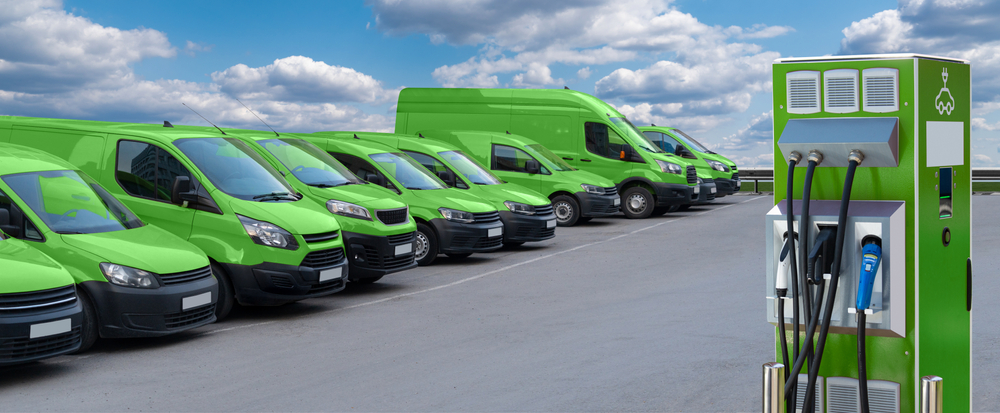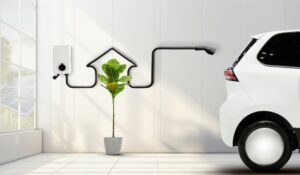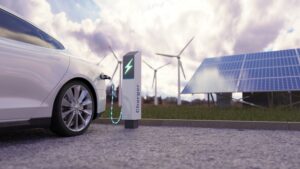
What you need to know when considering the switch to an EV and how this may benefit you and our environment.
This month we are highlighting the Transport and Connectivity chapter in our Climate Emergency Response Plan through our Connect County Durham campaign. We are exploring different aspects of the theme, and how each can impact our daily lives. This week we are diving into Electric Vehicle infrastructure.
Our cars are huge polluters, especially for households who own multiple vehicles. For example, the average petrol car on the road in the UK produces the equivalent of 180g (173g if diesel) of CO2 every kilometre.
Overall, cars, trucks, buses and motorbikes all account for almost three quarters of the greenhouse gas emissions that come from transport. And one way we can reduce this is considering the switch to zero emission vehicles, including EVs.
What is a zero-emission vehicle?
Zero emission vehicles are vehicles that don’t directly emit any carbon emissions, for example, Electric vehicle (EV) or Hydrogen powered Vehicles.
Electric vehicles are paving a future with less pollutants in the air and minimal impact to the environment. Whether it’s cars, trucks, buses, bikes, these transport options are powered by electricity rather than fossil fuels, and in return, they don’t emit pollutants. The developments we have seen in the last decade alone have shaped the vision for the future of low to no-emission vehicles, whether that’s for short everyday distances or long road trips.
Whilst they are leading the charge in change, electric vehicles are more than just cars and vans. Electricity can be used to power push bikes, motorbikes, even boats, making all your journeys a little easier, more affordable, far more enjoyable and greater for our environment.
EVs are the future: but why?
The benefits of EVs stretch further than just carbon emissions, they can have a huge impact on your personal life too.
Affordability: The overall costs of an EV are coming down. The second-hand market is making EVs far more accessible, even if you have a smaller budget. Autotrader claimed that 1 in 3 second-hand EVs are under £20,000. But you don’t have to go pre-owned, around 21 new models of electric cars are priced under £30,000.
 Longevity: Battery technology is improving rapidly. If you are weary about purchasing a second hand vehicle, a battery health certificate can be supplied by dealers to give you as much information as possible about the longevity of it.
Longevity: Battery technology is improving rapidly. If you are weary about purchasing a second hand vehicle, a battery health certificate can be supplied by dealers to give you as much information as possible about the longevity of it.
Reliability and Lower Maintenance: Electric vehicles are simpler in design and don’t need as much maintenance as petrol or diesel vehicles. This is because they have very few moving parts and don’t need engine oil, antifreeze, or exhaust systems; meaning service and maintenance costs are lower.
Ease and Accessibility: Fuelling up your car can be done in the comfort of your home and there is no need to queue up for fuel at a petrol station. Not to mention that charge points are becoming more accessible for those who may not have space at home, meaning you could also charge up while doing your shopping, going for a walk, or at work. Besides cars, electric boats are sometimes built with solar panels to ensure you can keep running without having to dock and refuel.
Healthier for People and Reduce Pollution: Electric vehicles produce zero tailpipe emissions, helping reduce air pollution that worsens respiratory conditions like asthma and heart disease. In the case of electric boats, they also help reduce water pollution. Not to forget, EVs are much quieter than petrol or diesel engines, which means less noise pollution on our roads and in our cities, contributing to calmer, more liveable streets and neighbourhoods.
County Durham EV infrastructure
In the last few years, we have installed 173 public chargers overall, which is equal to 312 sockets across County Durham. In addition to those, we are currently installing 250 new charge points over the next few years. We are also working towards further funding for 200 additional charge points that are planned for 2027, making electric charging more accessible for everyone.
ZapMap is a useful resource for finding charge points around the country, meaning there is no need to worry about charging up your vehicle on long journeys as you can always find your nearest charge point. Of course, it’s always good practice to plan your journey same as you would need to refuel your petrol or diesel vehicle.
For more information you can visit our Durham County Council webpages.
Myths Around EVs
Of course, like with anything new, there comes a lot of scepticism, and why wouldn’t you be weary when there is so much misinformation out there? To help shake off any nervousness about EVs, here are some common myths that just aren’t necessarily true:
EVs catch fire
Data shows that electric vehicles are much less likely to catch fire than their petrol and diesel equivalents. For example, in 2022, Sweden’s Civil Protection and Emergency Management Agency reported that only 0.004 per cent of all battery-powered cars burned in a fire.
 There is nowhere to charge
There is nowhere to charge
At the end of March 2025, there were 76,840 electric vehicle charging points across the UK, across 38,737 charging locations and 111,515 connectors. And with new projects being worked on consistently this number could be even bigger now.
They are not cheap to run
Electric can cost a lot less than petrol or diesel. Owners can save up to £750 a year if they mostly charge at home. If you have or are thinking about investing in solar panels this could reduce even further. Solar power is already in use on electric boats to keep costs low and the engine running.
The range is poor
On average, Brits drive 127 miles a week, with the most common uses being grocery shopping, visiting friends and family and shopping for other goods. A single charge typically lasts up to 250 miles meaning the average household in the UK would need to charge their electric vehicle less than once a week.
In conclusion, electric vehicles are no longer a distant dream, they are a practical, reliable, and an increasingly affordable solution for everyday transport. By embracing EVs and dispelling the myths that surround them, we can all play a part in reducing our impact on our environment and carbon footprint, supporting to build a more sustainable future for our youth.
We would love to hear from you
Share your stories, experiences, and photos of nature, and send us a few lines on how you are helping protect our environment in County Durham. Whether it is something you do personally, a community project you may be involved in, a business change or action, or even a great photo of nature. We want to celebrate and share your efforts and views.
Send us your stories or photos (with a short explanation) by emailing climatecountydurham@durham.gov.uk or by filling in our Get in Touch form and help inspire others across our beautiful county to take action. And do not forget to sign up to our Climate Change and Carbon Reduction Pledge.

